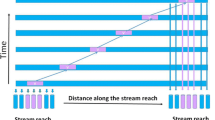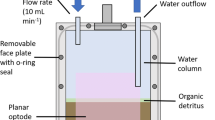Abstract
A mesocosm experiment determined the impact of Canada Goose (Branta canadensis) feces on water chemistry. After 30 days of fecal additions (treatments of 1.209, 2.419 g, and 12.090 g every 3 d to 0.811 m3 size mescosms), no significant changes in water column total phosphorus, nitrate, N:P ratios, total Kjeldahl nitrogen, chlorophyll-a, or phycocyanin were observed among treatment groups. Soluble reactive phosphorus showed a marginally significant increase in the high treatment group. A settling experiment suggested that goose feces and associated nutrients settled quickly to the sediment. Since fecal material settles quickly to the sediment, the impact of additional fecal material would not become evident in a lake until a wind event mixes the sediment into the water column or through alteration of the productivity or community structure of the benthos.




Similar content being viewed by others
References
Abraham, K. F. & R. L. Jefferies, 1997. High goose populations: Causes, impacts and implications. In Batt, B. (ed.), Arctic Ecosystems in Peril: Report of the Arctic Goose Habitat Working Group. Arctic Goose Joint Venture, Canadian Wildlife Service, Ottawa and US Fish and Wildlife Service, Washington, D.C., 7–72. (ISBN 0-9617279-3-4).
Ankney, C. D., 1996. An embarrassment of riches: too many geese. Journal of Wildlife Management 60: 217–223.
APHA. 1999. Standard Methods for the Examination of Waste and Wastewater. 19th edn. American Public Health Association, Washington, D.C.
Bedard, J. & G. Gauthier, 1986. Assessment of faecal output in geese. Journal of Applied Ecology 23: 77–90.
Carmichael, W. W. & J. An, 1999. Using an enzyme linked immunosorbent assay (ELISA) and a protein phosphatase inhibition assay (PPIA) for the detection of microcystins and nodularins. Natural Toxins 7: 377–385.
Dawson, R. M., 1998. The toxicology of microcystins. Toxicon 36: 953–963.
Dennis, D. G., N. R. North & H. G. Lumsden (2000) Range expansion and population growth of giant Canada geese in southern Ontario: benefits, drawbacks, and management techniques. Pages 159–165 In Dickson, K. (ed.). Towards conservation of diversity of Canada geese (Branta Canadensis) Can. Wildl. Serv. Occas. Pap. 103, 168 pp.
Harris, H. J. Jr., J. A. Ladowski & D. J. Worden, 1981. Water-quality problems and management of an urban waterfowl sanctuary. Journal of Wildlife Management 45: 501–507.
Hisbergues, M., G. Christiansen, L. Rouhiainen, K. Sivonen & T. Börner, 2003. PCR-based identification of microcystin-producing genotypes of different cyanobacterial genera. Archives of Microbiology 180: 402–410.
Hope, J., 2000. The geese that came in from the wild. Audubon 102: 122–127.
James, C.P. and H.A. James, 1993. An analytical method for anatoxin-a, a blue green algal neurotoxin in reservoir water. Report no. FR0363. Foundation for Water Research.
James, R. A. 2000. Dispersal patterns of giant Canada geese (Branta canadensis maxima), in the Central United States. Masters thesis, University of Arkansas, Arkansas, USA, 1–2.
Kear, J. 1963. The agricultural importance of wild goose droppings. The Waterfowl Trust, 14th Annual Report, 1961–1962, 72–77.
Kitchell, J. F., D. E. Schindler, B. R. Herwig, D. M. Post, M. H. Olson & M. Oldham, 1999. Nutrient cycling at the landscape scale: the role of diel foraging migrations by geese at the Bosque del Apache Wildlife Refuge. Limnology and Oceanography 44: 828–836.
Maccarrone, A. D. & C. H. Cope, 2004. Recent trends in the winter population of Canada Geese (Branta canadensis) in Wichita, Kansas: 1998–2003. Transactions of the Kansas Academy of Science 107: 77–82.
Mallory, M. L., A. J. Fontaine, P. A. Smith, M. O. Wiebe Robertson & H. G. Gilchrist, 2006. Water chemistry of ponds on Southampton Island, Nunavut, Canada: effects of habitat and ornithogenic inputs. Archiv fur Hydrobiologie 166: 411–432.
Manny, B. A., R. G. Wetzel & W. C. Johnson, 1975. Annual contribution of carbon, nitrogen and phosphorus by migrant Canada geese to a hardwater lake. Verhandlungen—Internationale Vereinigung für Theoretische und Angewandte Limnologie 19: 949–951.
Manny, B. A., W. C. Johnson & R. G. Wetzel, 1994. Nutrient additions by waterfowl to lakes and reservoirs: predicting their effects on productivity and water quality. Hydrobiologia 279/280: 121–132.
Marion, L., P. Clergeau, L. Brient & G. Bertru, 1994. The importance of avian-contributed nitrogen (N) and phosphorus (P) to Lake Grand-Lieu, France. Hydrobiologia 279/280: 133–147.
Olson, M. H., M. M. Hage, M. D. Binkley & J. R. Binder, 2005. Impact of migratory snow geese on nitrogen and phosphorus dynamics in a freshwater reservoir. Freshwater Biology 50: 882–890.
Oliver, J. D. & T. Legović, 1988. Okefenokee marshland, before during and after nutrient enrichment by a bird rookery. Ecological Modeling 43: 195–223.
Pettigrew, C. T., B. J. Hahn & L. G. Goldsborough, 1998. Waterfowl feces as a source of nutrients to a prairie wetland: responses of microinvertebrates to experimental additions. Hydrobiologia 362: 55–66.
Post, D. M., J. P. Taylor, J. F. Kitchell, M. H. Olson, D. E. Schindler & B. R. Herwig, 1998. The role of migratory raterfowl as nutrient vectors in a managed wetland. Conservation Biology 12: 910–920.
Schindler, D. W., F. A. J. Armstrong, S. K. Holmgren & G. J. Brunskill, 1971. Eutrophication of Lake 227, Experimental Lakes Area, Northwestern Ontario, by addition of phosphate and nitrate. Journal of the Fisheries Research Board of Canada 28: 1763–1781.
Scherer, N. M., H. L. Gibbons, K. B. Stoops & M. Muller, 1995. Phosphorus loading of an urban lake by bird droppings. Lake and Reservoir Management 11: 317–327.
U. S. Fish and Wildlife Service, 2003a. New York, Eastern Ontario and Southern Quebec Waterfowl Breeding Population Survey. U.S. Department of the Interior, Washington, D.C.
U. S. Fish and Wildlife Service, 2003b. Waterfowl population status, 2003. U.S. Department of the Interior, Washington, D.C.
Ward, H. B. & G. C. Whipple, 1918. Freshwater Biology. 2nd ed. John Wiley and Sons, Inc., New York, NY.
Watson, S. B., E. McCauley & J. A. Downing, 1997. Patterns in phytoplankton taxonomic composition across temperate lakes of differing nutrient status. Limnology and Oceanography 42: 487–495.
Wetzel, R. G. & G. E. Likens, 2000. Limnological Analyses. 3rd edn. Springer-Verlag, New York, Inc.
Zar, J. H., 1999. Biostatistical Analysis, 4th edn. Prentice Hall, Upper Saddle River, NJ.
Zhou, L., H. Kassa, M. L. Tischler & L. Xiao, 2004. Host-adapted cryptosporidium spp. in Canada geese (Branta Canadensis). Applied and Environmental Microbiology 70: 4211–4215.
Acknowledgements
We thank C. Norment, J. Haynes, T. Lewis, K. Martens and A. Hanson for their constructive comments that improved an earlier version of the manuscript. D.J. White, S. Halbrend, W. Guenther and J.A. Somarelli assisted with sample analysis.
Author information
Authors and Affiliations
Corresponding author
Additional information
Handling editor: K. Martens
Rights and permissions
About this article
Cite this article
Unckless, R.L., Makarewicz, J.C. The impact of nutrient loading from Canada Geese (Branta canadensis) on water quality, a mesocosm approach. Hydrobiologia 586, 393–401 (2007). https://doi.org/10.1007/s10750-007-0712-8
Received:
Revised:
Accepted:
Published:
Issue Date:
DOI: https://doi.org/10.1007/s10750-007-0712-8




